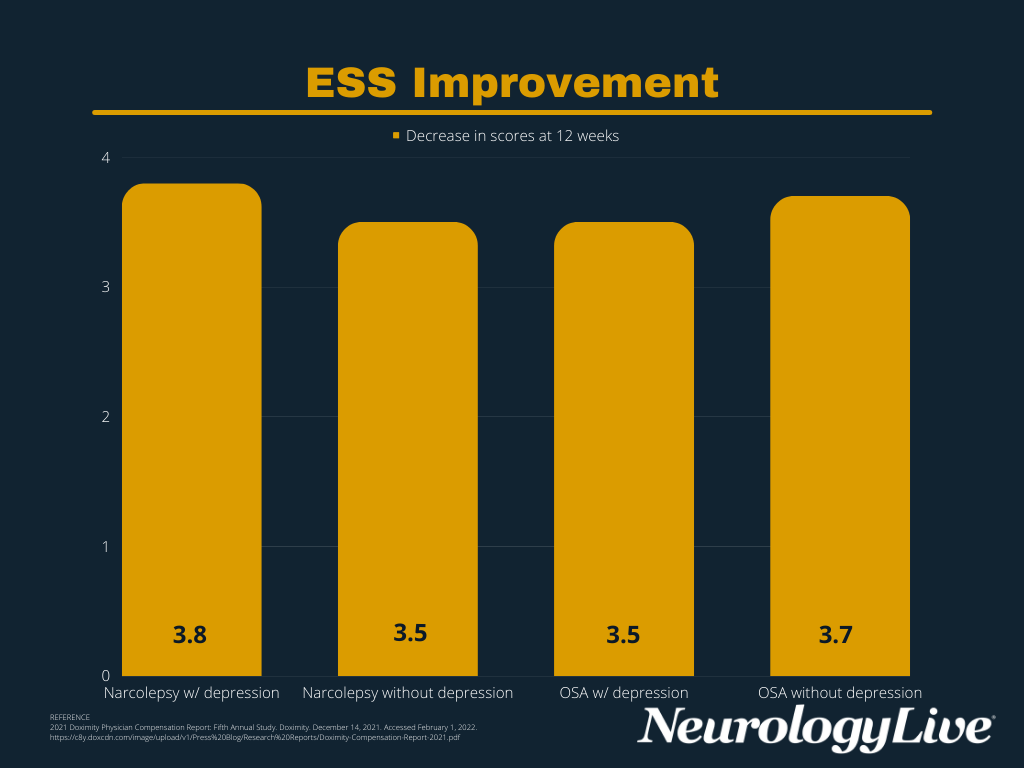News
Article
Depression History Shows No Impact on Efficacy, Safety of Solriamfetol in Treating Obstructive Sleep Apnea, Narcolepsy
Author(s):
Results of solriamfetol were similar when outcomes were examined in subgroups of concomitant antidepressant use, regardless of depression history, indicating that antidepressants did not affect the efficacy of the drug.
Andrew Krystal, MD

Recently published findings using cohort of patients with obstructive sleep apnea (OSA) or narcolepsy showed that treatment with solriamfetol (Sunosi; Axsome Therapeutics) remained safe and effective regardless of whether patients had a history of depression. Moreover, the investigators concluded that these data emphasize the high prevalence of depression in people with sleep disorders and suggest that increased awareness of this association may have clinical significance.
The analysis, led by Andrew Krystal, MD, professor of psychiatry, UCSF Weill Institute for Neurosciences, included 2 studies of patients with narcolepsy or OSA who were randomized to either placebo or solriamfetol 37.5 mg/day (OSA only), 75 mg/day, 150 mg/day, or 300 mg/day for 12 weeks. Among the groups, 27.5% (n = 65) of patients with narcolepsy (n = 236) had depression and 23.4% (n = 111) of those with OSA had depression (n = 474). Excessive daytime sleepiness (EDS) was assessed objectively with the 40-min Maintenance of Wakefulness Test (MWT) and by self-report with the Epworth Sleepiness Scale (ESS). Patient Global Impression of Change (PGI-C) was used to assess change in overall condition.
At the conclusion of the treatment period, results showed that MWT sleep latency improved by 5.4 mins and 7.0 mins among those with and without a history of depression in the narcolepsy group. As for OSA, the same groups showed improvements of 7.7 mins and 10.7 mins, respectively. Results were generally dose-dependent, with greater improvements in both the narcolepsy and OSA groups observed with higher doses of solriamfetol, relative to placebo, regardless of whether participants had a history of depression.

In the narcolepsy group, ESS scores decreased (improved) by –3.8 and –3.5 for those with and without a history of depression, respectively. From baseline to week 12, least square mean changes ranged from –1.76 to –5.44 in those with a history of depression and from –4.61 to –6.65 in those without a history of depression. Similar findings were observed in the OSA group, with ESS scores decreasing by –3.5 and –3.7 in those with and without depression, respectively. These data remained similar after excluding participants without a history of depression who were taking antidepressants.
READ MORE: A Balancing Challenge: Social Relationships in the Life of Adolescents With Narcolepsy
Solriamfetol-treated participants with narcolepsy or OSA reported improvement in their overall condition on the PGI-C at week 12, regardless of depression history. For narcolepsy, the mean percentage change from placebo in percentage of participants who improved was 31.7% in those with a history of depression and 39.4% in those without. For the combined solriamfetol group in patients with OSA, the mean percentage difference from placebo in percentage of participants improved on PGI-C was 41.1% in those with a history of depression and 29.4% in those without a history of depression.
In terms of safety, solriamfetol continued to be well-tolerated, although there were slight differences in subgroups of patients with depression. While the frequency and type of common treatment-emergent adverse events (TEAEs) were similar in those with and without depression in the OSA group, TEAEs occurred more frequently among those with a history of depression in the narcolepsy group (75 mg: 69%; 150 mg: 90%; 300 mg: 92%; combined solriamfetol: 83%) than those without a history of depression (75 mg: 54%; 150 mg: 74%; 300 mg: 62%; combined solriamfetol: 63%). Results were similar across the study when participants without a history of depression who were taking antidepressants were excluded.
Reports of suicidal ideation or behavior, as assessed with the C-SSRS, were uncommon, regardless of depression history. Three participants with narcolepsy and depression on solriamfetol had shifts from 0 (“no suicidal ideation/behavior”) to 1 (“wish to be dead”) post-baseline at weeks 4, 8, or 12. One solriamfetol-treated patient with OSA had a shift from 0 at baseline to 1 at week 8.


